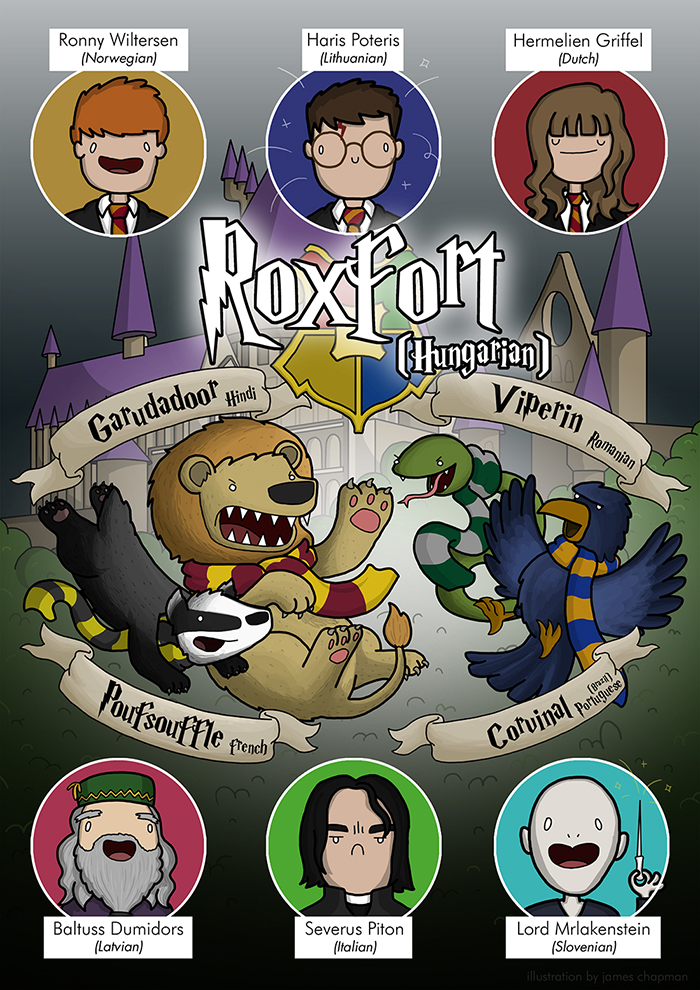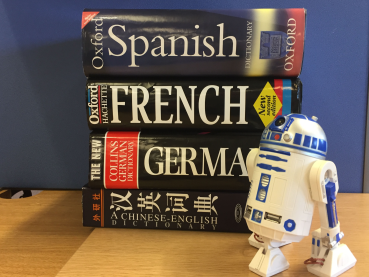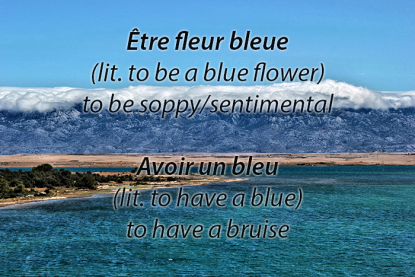As a lecturer in languages I often recommend to my students that as a first book to read in the language they’re learning they pick up a translation of their favourite book. Being familiar with the characters and plot of the book means that even if they don’t understand many words in the book, they don’t have to struggle with the vocabulary or the plot, as they know what’s happening. It can also be fun to discover what has been changed in the translation. The Harry Potter series provides a lot of variations that can keep the reader amused as they compare the translations with the original.
It’s well-known that the US title of the first book, Harry Potter and the Philosopher’s Stone, was changed to Harry Potter and the Sorcerer’s stone for the US market. But that, together with US spelling, was only a tiny change compared to the changes Harry and his friends have been through as the books have been translated into 80 languages other than English.
The US market wasn’t the only one to change the title of the first to avoid a reference to philosophy, as this was seen as off-putting for a children’s book. The French title avoids any reference to a stone altogether with Harry Potter à l'école des sorciers (Harry Potter at the Wizards’ School). The seventh book, Harry Potter and the Deathly Hallows, proved difficult to translate, so J.K. Rowling provided translators with the alternative title Harry Potter and the Relics of Death, which was the basis for most of the international translations. Translators had to be creative with the title of the latest book in the series, Harry Potter and the Cursed Child. The English title is ambiguous as to the gender of the child in question, and there are several candidates as to who the cursed child is in the plot, so translators had to either use words that kept the ambiguity (such as the French Harry Potter et l'enfant maudit), or use other words which kept the gender neutral. In Italian the book title becomes Harry Potter and the curse of the heir (Harry Potter e la maledizione dell'erede) and in Spanish it’s translated as Harry Potter and the cursed legacy (Harry Potter y el legado maldito).
 Some of the translations from the Harry Potter series.
Some of the translations from the Harry Potter series.
Most translators kept the names of characters and places very close to the originals, but the Italian and Norwegian translators applied more creativity to their texts. In Italian we find names such as Albus Silente, Severus Piton, and Minerva McGranitt, who in turn are called Albus Humlesnurr, Severus Slur and Minerva McSnurp in Norwegian.
Harry’s name remains the same in most of the translations, with some slight variations to his first name (Harri in Welsh and Harrius in Latin) or his full name (Harijs Poters in Latvian, Haris Poteris in Lithuanian, and Hari Poter in Serbian). Ron Weasley has a few minor alterations except in Norwegian, where he becomes Ronny Wiltersen, and Hermione keeps her name pretty much intact (even the Norwegian translator keeps her name recognisable with Hermine Grang) but the pronunciation of her name is mostly changed to the literal sounds as read in each language (hence she becomes err-me-oh-neh in Spanish, or err-me-onn in French).
Some of my favourite character names in other languages include Slatan Sharmer (Gilderoy Lockhart in Slovenian), Noldus / Zgredek (Dobby in Norwegian and Polish respectively), and Lord Mrlakenstein (Voldemort in Slovenian).
Hogwarts becomes Poudlard in French and Roxfort in Hungarian, and the four houses have variations such as Garudadoor (Gryffindor in Hindi), Poufsuffle (Hufflepuff in French), Corvinal (Ravenclaw in Brazilian Portuguese) and Viperin (Slytherin in Romanian).
J. K. Rowling’s playful and creative use of language posed many challenges for the translators involved, such as keeping the play on words of places like Diagon Alley, or what to call the Mirror of Erised (as the name had to read “desire” when read backwards). Perhaps one of the most challenging tasks came in Harry Potter and the Chamber of Secrets: the name Tom Marvolo Riddle was an anagram of “I am Lord Voldemort”, and to keep this the name translators had to either keep the name and provide the answer to the riddle in English followed by a translation, or change the name. In French, Tom became Tom Elvis Jedusor (Je suis Voldemort), in Dutch his name is Marten Asmodom Vilijn (Mijn naam is Voldemort), and in Spanish he is Tom Sorvolo Ryddle (Soy Lord Voldemort).
Leaving translation aside for a final thought, it is interesting that all human characters in the original version of the Harry Potter series speak English (sometimes with stereotypical accents such as Fleur’s or Viktor Krum’s). Other species such as the merpeople and goblins speak Mermish and Gobbledegook respectively, but the only other language we hear other human beings speak is Parseltongue, the language of snakes and other “dark” creatures - as well as Lord Voldemort. However, being a parselmouth (a speaker of Parseltongue) appears to be hereditary, so no-one (not even Hermione!) in the Harry Potter series studies languages. Knowing that J.K. Rowling was a language teacher before she became a published writer, I wish at least one of the characters could have been a role model for language learning.
Do what Hermione didn't - learn a language!
 This article is part of our Harry Potter collection - a series of academic insights exploring some of the themes, interests and general wizardry in the novels written by J.K. Rowling.
This article is part of our Harry Potter collection - a series of academic insights exploring some of the themes, interests and general wizardry in the novels written by J.K. Rowling.
You can view our Happy Birthday Harry Potter! hub here to read all the articles. Mischief managed!





Rate and Review
Rate this article
Review this article
Log into OpenLearn to leave reviews and join in the conversation.
Article reviews